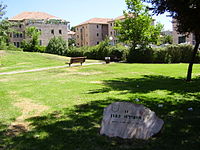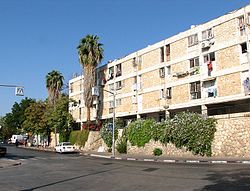- Katamon
-
Katamon (Arabic: قطمون, Hebrew: קטמון) is a neighbourhood in south-central Jerusalem, Israel. The official Hebrew name, Gonen (Hebrew: גּוֹנֵן), is only used in municipal publications. [1]Katamon is derived from the Greek kata tōi monastēriōi ("below the monastery").[2]
Contents
History
Katamon was established just before World War I. German aerial photographs taken during the war show a grid of building lots demarcated by stones.[3] By 1914, a total of 5 homes had been built.[4] From 1924, building activity resumed, mostly by affluent Christian Arabs, who built large mansions there.
At the beginning of the 1948 Arab-Israeli war the neighborhood was an Arab salient between two Jewish neighborhoods. On the night of 5–6 January 1948, the Haganah bombed the Semiramis Hotel in Katamon, killing 24 or 26 people. On April 28, as part of Operation Yevusi, during a bloody battle over control of the Greek Orthodox St. Simon monastery, located on a strategic hilltop, Rafael Eitan, then a platoon commander, was shot in the head.[5] Many others were killed and wounded on both sides. After the surrender of the Jewish Quarter at the end of May, around 1000 Jewish refugees were moved into Katamon.[6] A gutted Jordanian Legion tank was left as a monument at St. Simon park, but was removed in the late 1990s.
In her autobiography, Palestinian author Ghada Karmi describes growing up in Katamon, from which she and her father, linguist Hasan Karmi, and the rest of the family, fled in 1948 after fierce fighting broke out. Arab scholar and poet Khalil al-Sakakini and writer Sami Hadawi also left Katamon at this time. Al-Sakakini's daughter Hala wrote about revisiting the neighborhood in 1967.[7]
On September 17, 1948, UN Mediator Folke Bernadotte and UN Observer André Serot, were assassinated by members of the Jewish underground while driving on Palmach Street in Katamon.[8]
Geography
Katamon is bounded by the neighborhoods of Talbiya in the northeast, and the German Colony and Greek Colony to the southeast. The neighbourhood is bounded on its south side by Rachel Imenu street and Hizkiyahu Ha'Melech street (separating it from the Greek Colony), and on its east side by Kovshey Katamon street (separating it from Talbiya). These streets connect to Emek Refaim and Rehov ha-Palmach,[9] respectively.
Landmarks
A major site in Katamon was the St. Simon monastery, on a hilltop to the north. The monastery is now surrounded by a large park in the neighborhood known as Givat Oranim.
The neighbourhood was home to the Hapoel Jerusalem football club from the 1930s until it moved back to the YMCA Stadium in the 1980s.[10] In 2007, several dissatisfied Hapoel Jerusalem fans formed a new club, naming it Hapoel Katamon Jerusalem after the club's former home, although the new club does not play in the neighborhood.[11]
Katamon was the home of several foreign consulates, among them the Greek consulate, the Italian consulate, and the Costa-Rican consulate.[12] The old Hapoel stadium was purchased by developers and is now the site of the upscale Ganei Katamon neighborhood, ringing Ofira Navon park.
The Misgav Ladach hospital on the southern edge of the neighbourhood specialized in maternity care, but is now a Kupat Holim Meuhedet diagnostic center.[13] The L. A. Mayer Institute for Islamic Art is also located on Palmach Street in Katamon.[14] Katamon also houses the core community of Erloi Hassidism, as well its yeshiva, Ohel Shimon.[15] The International Christian Embassy Jerusalem has been based in Katamon since 1997.
Katamonim
To the west, Old Katamon branches out into several neighbourhoods collectively called the "Katamonim" (officially "Gonenim," lit. "Defenders"), built in the early years of the state to accommodate the large wave of new immigrants, previously living in tent camps.[16] These neighborhoods were assigned Hebrew numerals : Katamon Khet ("Katamon 8"), Katamon Tet ("Katamon 9), etc. Some of those neighborhoods have a second name. Katamon Hei (5) is also called San Simon Neighborhood,[17] a part of Katamon Het (8) and Katamon tet (9) is sometimes called San Martin Neighborhood,[18] and Katamon zayn (7) is Pat neighborhood.
Katamon Khet was built at the end of the 1950s, and Katamon Tet in the mid-1960s. The Katamonim are characterized by long apartment blocks on pillars, providing low-cost housing. Some of the buildings are still government-owned, although the Amidar housing company sold many of the apartments to the residents in the 1970s.[19]
Prior to the Six-Day War in June 1967, the Katamonim were on the Jordanian-Israeli armistice line. Massive infrastructure improvement was financed by an urban renewal project known as "Project Renewal" over a period of two decades. Many small apartments were combined into larger ones and the outward appearance of the apartment blocks was improved.[20] Since the 1990s, many Russian and Ethiopian immigrants have been given housing here.[21]
The Jerusalem Tennis Center, founded in 1981 and dedicated in 1982 by the Jewish community of South Africa in memory of Yossi Zeituni, a tennis coach who fell in the Lebanon War, is located in the Katamonim. The center has 19 courts and a stadium with seating for 2,000 spectators.[22]
References
- ^ A stir over sign language, Haaretz
- ^ Aviva Bar Am, Katamon
- ^ Ruth Kark, Jerusalem neighborhoods
- ^ Ruth Kark, Jerusalem neighborhoods
- ^ Aviva Bar Am, Katamon
- ^ The Scotsman June 1st 1948: 'After the Jewish surrender over 1000 non-combatant residents were evacuated to Katamon, south-west of Jerusalem, 150 Jews were handed over to the Red Cross, and 350 prisoners taken to Transjordan.'
- ^ Jerusalem and I
- ^ Aviva Bar Am, Katamon
- ^ Jerusalem Real Estate Guide - A Pick Into The Most Desirable Districts Of Jerusalem Naldan Plus
- ^ Hapoel Jerusalem fans plan alternative team, The Jerusalem Post, 07/12/2007
- ^ Fan-owned soccer team http://www.haaretz.com/hasen/spages/914954.html
- ^ The discreet charm of the bourgeoisie
- ^ Misgav Ladach operating rooms shut down
- ^ Between two cultures, The Forward
- ^ Erloi chassidus
- ^ Jerusalem neighborhoods: Gonenim
- ^ אתר עיריית ירושלים
- ^ מכרז של רשות הדואר לסוכנות סן מרטין
- ^ Jerusalem neighborhoods: Gonenim
- ^ Jerusalem neighborhoods: Gonenim
- ^ Jerusalem neighborhoods:Gonenim
- ^ Jerusalem Tennis Center
Bibliography
- Sakakini, Hala: Jerusalem and I, 1987
- Karmi, Ghada: In Search of Fatima: A Palestinian Story ISBN 1-85984-694-7 Verso 2002
- A country of the mind Guardian, Saturday October 19, 2002 (from Dr Ghada Karmi's memoir, In Search of Fatima)
Coordinates: 31°45′40″N 35°12′25″E / 31.761°N 35.207°E
Neighborhoods of Jerusalem Old City East Jerusalem American Colony • Al Bustan • Al-Issawiya • At-Tur • Bab a-Zahara • Beit Hanina • Jabel Mukaber • Ma'ale ha-Zeitim • Nachalat Shimon • Nof Zion • Ras al-Amud • Sheikh Jarrah • Shimon HaTzadik • Shuafat • Silwan • Sur Baher • Umm Tuba • Wadi al-JozHaredi neighborhoods Batei Munkatch • Batei Ungarin • Beit Yisrael • Ezrat Torah • Geula • Givat Shaul • Har Nof • Kerem Avraham • Kiryat Belz • Kiryat Mattersdorf • Kiryat Sanz • Kiryat Shomrei Emunim • Machanayim • Mea Shearim • Mekor Baruch • Nachalat Ya'akov • Ramat Shlomo • Ramot Polin • Sanhedria • Sanhedria Murhevet • Sha'arei Hesed • Shmuel HaNavi • Tel Arza • Unsdorf • Zikhron MosheCentral Neighborhoods Batei Nissan Bak • Beit David • Beit Ya'akov • Bukharan neighborhood • Even Yisrael • Ezrat Yisrael • Givat Ram • Katamon • Kiryat Shmuel • Kiryat Wolfson • Mahane Israel • Mahane Yehuda • Merhavia • Mishkenot Sha'ananim • Musrara • Nachalat Achim • Nachlaot • Nayot • Neve Sha'anan • Ohel Shlomo • Rehavia • Yemin MosheNorthern Neighborhoods French Hill • Givat HaMivtar • Ma'alot Dafna • Neve Yaakov • Pisgat Ze'ev • Ramat Eshkol • Ramot • Ramot PolinSouthern Neighborhoods Abu Tor • Baka • Beit Safafa • East Talpiot • The German Colony • Gilo • Givat HaMatos • Greek colony • Har Homa • Mekor Chaim • Ramat Rachel • TalpiotWestern Neighborhoods Bayit VeGan • Beit HaKerem • Givat Massuah • Givat Mordechai • Givat Oranim • Har Hotzvim • Ir Ganim • Katamonim • Kiryat HaYovel • Kiryat Menachem • Kiryat Moshe • Malha • Motza • Pat • Ramat Beit HaKerem • Ramat Denya • Ramat Sharett • Romema • Yefeh NofHistoric Neighborhoods See also: Ring NeighborhoodsCategories:- Neighbourhoods of Jerusalem
Wikimedia Foundation. 2010.





